About four hours from where I live is a spiritual retreat center called Trout Lake Abbey, which is the home of Mt. Adams Zen Buddhist Temple (MAZBT). Nestled in a small valley at the foot of Washington state's Mount Adams, it is a beautiful and peaceful place to spend time in contemplation away from the bustle of city life. Since I discovered it a few years ago, I have been making an effort to get there at least once a month or so. More often than not, I am joined by Fa Lohng Shakya, and the two of us spend time practicing in the temple and enjoying the clean mountain air.
About four hours from where I live is a spiritual retreat center called Trout Lake Abbey, which is the home of Mt. Adams Zen Buddhist Temple (MAZBT). Nestled in a small valley at the foot of Washington state's Mount Adams, it is a beautiful and peaceful place to spend time in contemplation away from the bustle of city life. Since I discovered it a few years ago, I have been making an effort to get there at least once a month or so. More often than not, I am joined by Fa Lohng Shakya, and the two of us spend time practicing in the temple and enjoying the clean mountain air.
The abbot of MAZBT, Venerable Thich Minh Tinh, is a teacher in the Vietnamese Thien (Zen) tradition who also spent many years practicing Japanese Zen. Living at a spiritual retreat center, he encounters pilgrims of many faiths from all over the world, and through such encounters he established relationships with two Chan masters from China.
The first, Abbot Ming Chan of Jiashan Temple in Hunan province, came to the United States several years ago and spent some time at MAZBT. Ever since then, he had been excited to return the favor and had been inviting Ven. Minh Tinh to visit him at Jiashan.
The second, Master Wan Xing of Dong Hua Temple in Wengyuan City, has a student living in the United States, Susan Bankson. Susan is a Chinese-American laywoman who has helped Master Wan Xing with translating his books into English. A chance visit to MAZBT got her working with Ven. Minh Tinh on getting one such book, Seclusion and Awakening, published in English. Because of his efforts, Ven. Minh Tinh was now invited to come to Dong Hua.
Since I had helped edit the English version of Seclusion and Awakening, and because Fa Lohng and I had been spending so much time with Ven. Minh Tinh and practicing at MAZBT, we soon found ourselves invited to come with him to visit both temples. So, along with half a dozen other travelers, and Susan as our translator, in October, 2014, we were off to China!
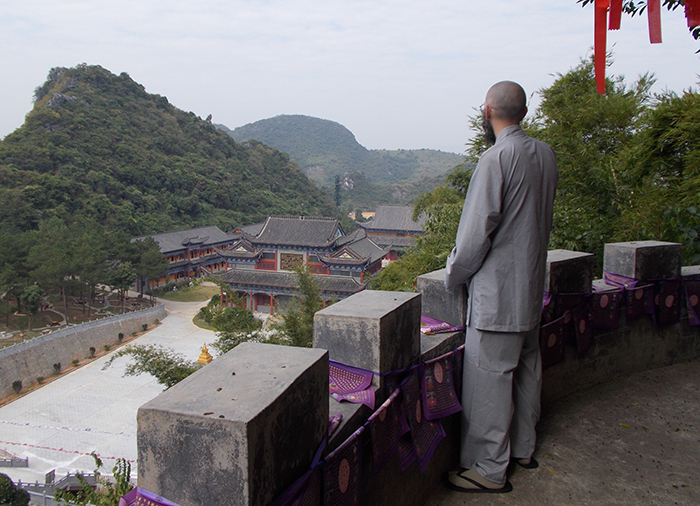 The author looking over the grounds at Dong Hua TempleOn an early autumn day, we flew in to Guangzhou (formerly Canton), in southeastern China, and from there we traveled several hours by bus to Dong Hua Temple. We spent the first half of our trip there, where we joined in the regular monastic practice schedule of the monks and nuns, including several services each day of chanting while standing, bowing, and walking in procession. We also did Qi Gong practice in the morning and evening and seated meditation at night. During some of the free periods, we were given tours of the massive temple complex - Dong Hua is a beautiful new facility that has been built on the site of an ancient temple of the same name. It runs up a narrow valley, enfolded by two rows of steep, forested hills. The hills have many natural caves, including the Three Sages Cave, where Master Wan Xing practiced in solitary confinement for three years. At the foot of the valley is a farm that produces food for the temple, and we visited with the farmers while touring the fields.
The author looking over the grounds at Dong Hua TempleOn an early autumn day, we flew in to Guangzhou (formerly Canton), in southeastern China, and from there we traveled several hours by bus to Dong Hua Temple. We spent the first half of our trip there, where we joined in the regular monastic practice schedule of the monks and nuns, including several services each day of chanting while standing, bowing, and walking in procession. We also did Qi Gong practice in the morning and evening and seated meditation at night. During some of the free periods, we were given tours of the massive temple complex - Dong Hua is a beautiful new facility that has been built on the site of an ancient temple of the same name. It runs up a narrow valley, enfolded by two rows of steep, forested hills. The hills have many natural caves, including the Three Sages Cave, where Master Wan Xing practiced in solitary confinement for three years. At the foot of the valley is a farm that produces food for the temple, and we visited with the farmers while touring the fields.
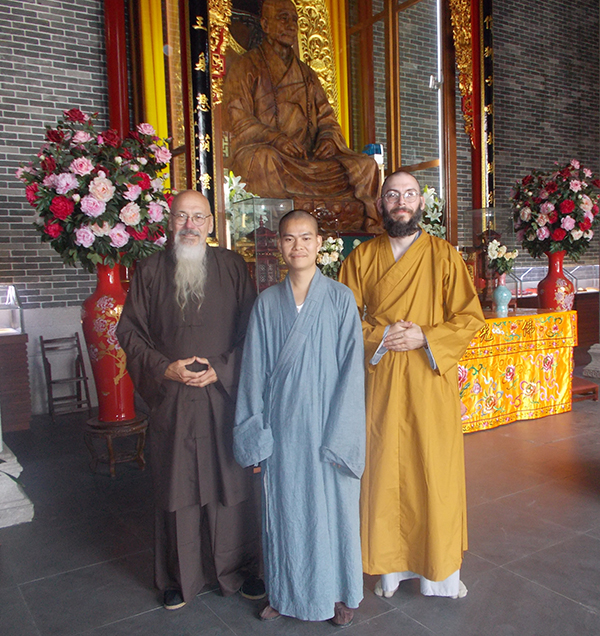 The author with Fa Lohng (left) and a senior temple monk (center) at Yun Men Temple When it was finally time for us to leave Dong Hua, we headed further inland, to Yun Men Temple. This temple had been a long-time home to our own Master Hsu Yun and his student, Master Foyuan. The current abbot, Master Ming Xiang, was Master Foyuan's student and is a good friend of Master Ming Chan, one of our two hosts and the sponsor of our entire trip. We had tea with Master Ming Xiang, after which he honored us by giving us a demonstration of his calligraphy brush work. A renowned calligrapher, the master painted pieces as custom gifts to my own Mountain Way Zendo, as well as to MAZBT (Ven. Minh Tinh), and Open Gate Zendo (Fa Lohng). Afterward, the head monk of the temple gave us a tour of the complex, which is situated at the foot of a forested hill. From rice fields to landscaped gardens, from the old Buddha Hall to the brand-new memorial pagoda - it was a place that blended new reverence with ancient tradition.
The author with Fa Lohng (left) and a senior temple monk (center) at Yun Men Temple When it was finally time for us to leave Dong Hua, we headed further inland, to Yun Men Temple. This temple had been a long-time home to our own Master Hsu Yun and his student, Master Foyuan. The current abbot, Master Ming Xiang, was Master Foyuan's student and is a good friend of Master Ming Chan, one of our two hosts and the sponsor of our entire trip. We had tea with Master Ming Xiang, after which he honored us by giving us a demonstration of his calligraphy brush work. A renowned calligrapher, the master painted pieces as custom gifts to my own Mountain Way Zendo, as well as to MAZBT (Ven. Minh Tinh), and Open Gate Zendo (Fa Lohng). Afterward, the head monk of the temple gave us a tour of the complex, which is situated at the foot of a forested hill. From rice fields to landscaped gardens, from the old Buddha Hall to the brand-new memorial pagoda - it was a place that blended new reverence with ancient tradition.
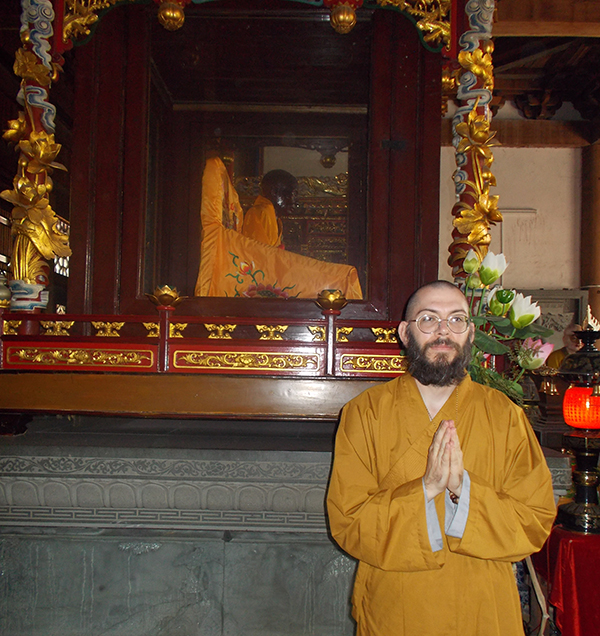 The author at Nan Hua monastery, with the mummy of Hui Neng, the sixth and last Chán patriarch.When we left Yun Men, Master Ming Xiang's hospitality followed us to Nan Hua Temple in Shaoguan City, where we were once again received as honored guests. Pilgrims come from far and wide to Nan Hua to visit the lacquered, mummified remains of Hui Neng, the sixth patriarch of Chan. As part of a personal tour by the head monk, we were escorted past the security barriers and tourists right into the memorial hall for a close-up view of the sixth patriarch and the chance to offer him incense as tribute. After the tour, we were treated to a wonderful lunch and given traditional string-bound reproduction copies of the patriarch's Platform Sutra.
The author at Nan Hua monastery, with the mummy of Hui Neng, the sixth and last Chán patriarch.When we left Yun Men, Master Ming Xiang's hospitality followed us to Nan Hua Temple in Shaoguan City, where we were once again received as honored guests. Pilgrims come from far and wide to Nan Hua to visit the lacquered, mummified remains of Hui Neng, the sixth patriarch of Chan. As part of a personal tour by the head monk, we were escorted past the security barriers and tourists right into the memorial hall for a close-up view of the sixth patriarch and the chance to offer him incense as tribute. After the tour, we were treated to a wonderful lunch and given traditional string-bound reproduction copies of the patriarch's Platform Sutra.
Leaving Nan Hua, we boarded a bullet train to Changsha City in Hunan Province. The trip itself was an incredible experience, traveling at nearly 200 miles per hour in greater comfort than on a standard jetliner. In two short hours, we traveled a distance that would have taken six or seven hours by car!
 Fa Lohng at Nan Hua Si, the mummified remains of Hui Neng above.At Changsha, we finally became direct guests of Abbot Ming Chan. He was in the city, a good five-hour drive from Jiashan Temple, for a two-day tea festival for the whole province. We joined him and his retinue of monks onstage during the festival's opening ceremony to perform the Buddhist blessing. We then spent the next two days attending tea ceremonies and demonstrations, listening to lectures, and examining teawares and sampling high-quality tea.
Fa Lohng at Nan Hua Si, the mummified remains of Hui Neng above.At Changsha, we finally became direct guests of Abbot Ming Chan. He was in the city, a good five-hour drive from Jiashan Temple, for a two-day tea festival for the whole province. We joined him and his retinue of monks onstage during the festival's opening ceremony to perform the Buddhist blessing. We then spent the next two days attending tea ceremonies and demonstrations, listening to lectures, and examining teawares and sampling high-quality tea. 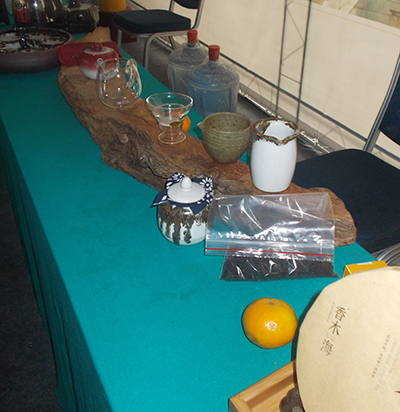 It was here that we learned that Jiashan Temple is considered the origin of tea as a Chan practice, as epitomized in the poetic Chinese phrase "Chan Cha Yi Wei" - Zen and Tea are One Flavor. This phrase was first penned at Jiashan, which is also the home of the Blue Cliff for which the Blue Cliff Record koan collection was named!
It was here that we learned that Jiashan Temple is considered the origin of tea as a Chan practice, as epitomized in the poetic Chinese phrase "Chan Cha Yi Wei" - Zen and Tea are One Flavor. This phrase was first penned at Jiashan, which is also the home of the Blue Cliff for which the Blue Cliff Record koan collection was named!
When our time at the tea expo was up, we then made the drive to the temple itself. We found that our arrival had been time to coincide with both a province-wide orange festival (Jiashan is surrounded by forests of orange orchards), and the opening dedication of a new temple building dedicated to tea ceremony and practice. We donned our robes and joined Master Ming Chan and the monks of Jiashan for the dedication of the tea building, starting with a brief service in the Buddha Hall and then walking in a procession to, through, and around the new building, chanting all the while. In between services, the rest of our all-too-brief time at Jiashan was spent in tea ceremony and instruction, paying homage in the various shrine halls, and walking through the orange-forested hillsides and visiting the various memorial stupas. 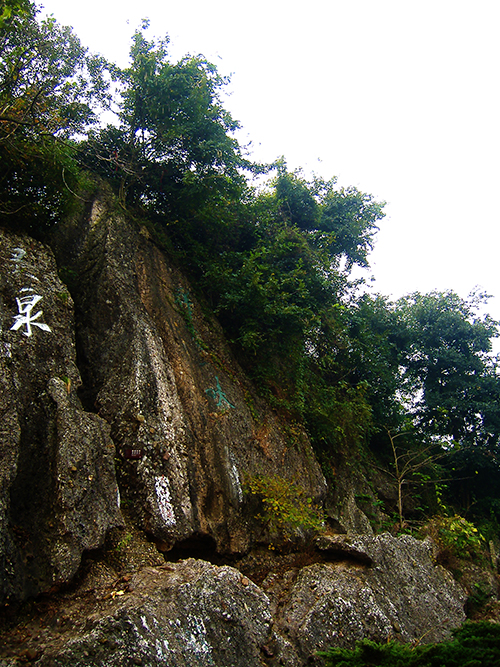 Blue Cliff, famously known from the Blue Cliff Record, a collection of koans used for teaching Chán during the Song dynasty.We also made pilgrimage to the clear springs and rocky faces of the Blue Cliff of legend, where we ascended the stone staircases of the cliff-face and paid our respects at the cave shrines.
Blue Cliff, famously known from the Blue Cliff Record, a collection of koans used for teaching Chán during the Song dynasty.We also made pilgrimage to the clear springs and rocky faces of the Blue Cliff of legend, where we ascended the stone staircases of the cliff-face and paid our respects at the cave shrines.
Master Ming Chan, who was very personable and radiated a good-humored nature, continued to take good care of us even as we were leaving his care. He sent us to Qiang Ming, his temple in Changde City, for a tour and a restful afternoon of lunch and, of course, tea. He then put us on an overnight train back to Guangzhou, where we would spend the next two days in a Buddhist district of the city, visiting the various shops of a Buddhist marketplace and touring two more temples.
The first of the temples, Guangxiao, was the temple where Hui Neng finally took the tonsure of ordination, long after becoming the sixth patriarch of Chan. In fact, while the head monk was giving us a personal tour, he pointed out two flag poles in the temple square and remarked that it was here that the Patriarch encountered two monks arguing over whether it was the flag or the wind moving, and gently pointed out to them that it was mind that moved.
Two blocks away is the Temple of Six Banyan Trees, a 1,400 year-old temple with a rich history and a famous pagoda that looks like a 9-story tower from the outside, but really has 17 stories on the inside! Small and tucked away in the busy streets of the city, it is nonetheless an island of peace amongst the bustle.
Between and around the two temples, the area is full of shops filled with everything from malas to robes to temple supplies. We spent plenty of time (and probably too much money) as we browsed their wonderful wares.
Our time in China finally at a close, we bid each other farewell as each of us moved on to the next leg of our journey. While some of us returned home, others went on to adventures in Thailand, Korea, and even India! There was so much seen and done that it is difficult for me to single out any particular aspect of the trip. I enjoyed the chance to visit, stay at, and practice at seven different Buddhist temples and to spend so much time steeped in tea culture. It was incredible to finally have a direct experience of several temples of historical significance to my own practice and tradition, with connections to Master Hsu Yun, Master Hui Neng, the famed Blue Cliff, and Tea Ceremony as a Chan practice. It was truly the trip of a lifetime, and my own life and practice will always be the richer for it.
